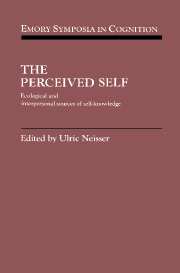Book contents
- Frontmatter
- Contents
- Preface
- List of contributors
- Part I Introduction
- Part II The concept of an ecological self
- Part III The interpersonal self and its implications
- 8 The self born in intersubjectivity: The psychology of an infant communicating
- 9 On the interpersonal origins of self-concept
- 10 Infants' knowledge of self, other, and relationship
- 11 The role of feelings for an interpersonal self
- 12 Spontaneous communication and the foundation of the interpersonal self
- 13 Autism, affordances, and the self
- 14 Through feeling and sight to self and symbol
- 15 G. H. Mead and Martin Buber on the interpersonal self
- 16 Cognitive science, other minds, and the philosophy of dialogue
- Author index
- Subject index
8 - The self born in intersubjectivity: The psychology of an infant communicating
Published online by Cambridge University Press: 29 March 2010
- Frontmatter
- Contents
- Preface
- List of contributors
- Part I Introduction
- Part II The concept of an ecological self
- Part III The interpersonal self and its implications
- 8 The self born in intersubjectivity: The psychology of an infant communicating
- 9 On the interpersonal origins of self-concept
- 10 Infants' knowledge of self, other, and relationship
- 11 The role of feelings for an interpersonal self
- 12 Spontaneous communication and the foundation of the interpersonal self
- 13 Autism, affordances, and the self
- 14 Through feeling and sight to self and symbol
- 15 G. H. Mead and Martin Buber on the interpersonal self
- 16 Cognitive science, other minds, and the philosophy of dialogue
- Author index
- Subject index
Summary
Introduction
The theory of interpersonal communication and its motives
In this chapter I shall analyze the condition of a human self around the time of birth, as seen when a baby is in communication with an other. Then I shall trace some important changes that have been recorded in the life of the communicating self through infancy.
Communication with persons is possible from birth, and we should not be surprised at this. It is in the nature of human consciousness to experience being experienced: to be an actor who can act in relation to other conscious sources of agency, and to be a source of emotions while accepting emotional qualities of vitality and feeling from other persons by instantaneous empathy. This interpersonal self, this person who breaks the private integrity of the ecological self, splitting its egocenter and reconstituting it as a part of a communication dipole or multipole, is fundamental to the human condition.
Nevertheless, our psychological tradition, observing the limited cognitive powers of the newborn and giving great value to the cultivated intelligence of an educated person, has assumed that the mind of an infant is incoherent, with undefined perceptions and incapable of contributing to communication, except to solicit help reflexively for biological functions.
- Type
- Chapter
- Information
- The Perceived SelfEcological and Interpersonal Sources of Self Knowledge, pp. 121 - 173Publisher: Cambridge University PressPrint publication year: 1994
- 61
- Cited by

